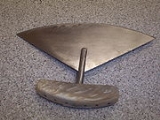
Ulu
Encyclopedia
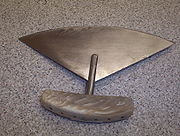
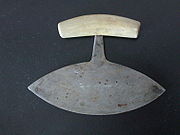
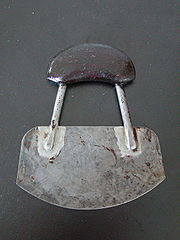
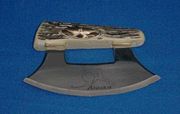
Knife
A knife is a cutting tool with an exposed cutting edge or blade, hand-held or otherwise, with or without a handle. Knives were used at least two-and-a-half million years ago, as evidenced by the Oldowan tools...
traditionally used by Eskimo
Eskimo
Eskimos or Inuit–Yupik peoples are indigenous peoples who have traditionally inhabited the circumpolar region from eastern Siberia , across Alaska , Canada, and Greenland....
women, both Yupik
Yupik
The Yupik , are a group of indigenous or aboriginal peoples of western, southwestern, and southcentral Alaska and the Russian Far East...
and Inuit
Inuit
The Inuit are a group of culturally similar indigenous peoples inhabiting the Arctic regions of Canada , Denmark , Russia and the United States . Inuit means “the people” in the Inuktitut language...
. It is utilized in applications as diverse as skinning and cleaning animals, cutting a child's hair, cutting food and, if necessary, trimming blocks of snow and ice used to build an igloo
Igloo
An igloo or snowhouse is a type of shelter built of snow, originally built by the Inuit....
. The ulu is still used today but not for cutting children's hair.
Name
In the NunatsiavummiututNunatsiavummiutut
The Nunatsiavummiut dialect, or Nunatsiavummiutut, also known as Labradorimiutut and called Inuttut by its speakers, is a dialect of the Inuit language...
dialect, spoken in Nunatsiavut
Nunatsiavut
Nunatsiavut is an autonomous area claimed by the Inuit in Newfoundland and Labrador, Canada. The settlement area includes territory in Labrador extending to the Quebec border. In 2002, the Labrador Inuit Association submitted a proposal for limited autonomy to the government of Newfoundland and...
, the word is spelled uluk, and in East Greenlandic it is sakiaq or saakiq and in syllabics is ᑭᖅ.
Materials
Traditionally the ulu was made with a caribouReindeer
The reindeer , also known as the caribou in North America, is a deer from the Arctic and Subarctic, including both resident and migratory populations. While overall widespread and numerous, some of its subspecies are rare and one has already gone extinct.Reindeer vary considerably in color and size...
antler
Antler
Antlers are the usually large, branching bony appendages on the heads of most deer species.-Etymology:Antler originally meant the lowest tine, the "brow tine"...
, muskox horn
Horn (anatomy)
A horn is a pointed projection of the skin on the head of various animals, consisting of a covering of horn surrounding a core of living bone. True horns are found mainly among the ruminant artiodactyls, in the families Antilocapridae and Bovidae...
or walrus ivory
Walrus ivory
Walrus tusk ivory comes from two modified upper canines. The tusks of a Pacific walrus may attain a length of one meter. Walrus teeth are also commercially carved and traded. The average walrus tooth has a rounded, irregular peg shape and is approximately 5cm in length.The tip of a walrus tusk has...
handle and slate
Slate
Slate is a fine-grained, foliated, homogeneous metamorphic rock derived from an original shale-type sedimentary rock composed of clay or volcanic ash through low-grade regional metamorphism. The result is a foliated rock in which the foliation may not correspond to the original sedimentary layering...
cutting surface, due to the lack of metal smelting technology in the Arctic
Arctic
The Arctic is a region located at the northern-most part of the Earth. The Arctic consists of the Arctic Ocean and parts of Canada, Russia, Greenland, the United States, Norway, Sweden, Finland, and Iceland. The Arctic region consists of a vast, ice-covered ocean, surrounded by treeless permafrost...
. The handle could also be carved from bone, and wood was sometimes used when it was available. In certain areas, such as Ulukhaktok
Ulukhaktok, Northwest Territories
Ulukhaktok is a small hamlet on the west coast of Victoria Island, in the Inuvik Region of the Northwest Territories, Canada. The 2006 census indicated a population of 398 of which 360 were Inuvialuit or Inuit along with 7.5% non-Aboriginal and 2.5% North American Indian...
Northwest Territories
Northwest Territories
The Northwest Territories is a federal territory of Canada.Located in northern Canada, the territory borders Canada's two other territories, Yukon to the west and Nunavut to the east, and three provinces: British Columbia to the southwest, and Alberta and Saskatchewan to the south...
, copper
Copper
Copper is a chemical element with the symbol Cu and atomic number 29. It is a ductile metal with very high thermal and electrical conductivity. Pure copper is soft and malleable; an exposed surface has a reddish-orange tarnish...
was used for the cutting surface.
Today the ulu is still often made with a caribou antler handle but the blade is usually made of steel
Steel
Steel is an alloy that consists mostly of iron and has a carbon content between 0.2% and 2.1% by weight, depending on the grade. Carbon is the most common alloying material for iron, but various other alloying elements are used, such as manganese, chromium, vanadium, and tungsten...
. The steel is quite often obtained by purchasing a hand saw
Hand saw
In woodworking and carpentry, hand saws, also known as "panel saws", "fish saws", are used to cut pieces of wood into different shapes. This is usually done in order to join the pieces together and create a wooden object. They usually operate by having a series of sharp points of some substance...
or wood saw and cutting the blade to the correct shape. A hardwood called sisattaq is also used for handles. These uluit are both kept for home use and sold to others. It is also possible to purchase commercially produced uluit, sometimes made with a plastic handle and complete with a cutting board.
Usage and styles
The size of the ulu typically reflects its usage. An ulu with a 5 cm (2 in) blade would be used as part of a sewing kit to cut sinewTendon
A tendon is a tough band of fibrous connective tissue that usually connects muscle to bone and is capable of withstanding tension. Tendons are similar to ligaments and fasciae as they are all made of collagen except that ligaments join one bone to another bone, and fasciae connect muscles to other...
. Kimaqtuut is a small ulu used for cutting out patterns from animals skins (seal, caribou) which is the two-inch blade. An ulu with a 15 cm (6 in) blade would be used for general purposes. Occasionally, uluit can be found with blades as large as 30 cm (11.8 in).
The ulu comes in four distinct styles, the Inupiat (or Alaska
Alaska
Alaska is the largest state in the United States by area. It is situated in the northwest extremity of the North American continent, with Canada to the east, the Arctic Ocean to the north, and the Pacific Ocean to the west and south, with Russia further west across the Bering Strait...
n), Canadian
Canada
Canada is a North American country consisting of ten provinces and three territories. Located in the northern part of the continent, it extends from the Atlantic Ocean in the east to the Pacific Ocean in the west, and northward into the Arctic Ocean...
, West Greenlandic and East Greenlandic. With the Inupiat style ulu the blade has a centre piece cut out and both ends of the blade fit into the handle. In Canada the blade more often is attached to the handle by a single stem in the centre. In the western areas of the Canadian Arctic
Northern Canada
Northern Canada, colloquially the North, is the vast northernmost region of Canada variously defined by geography and politics. Politically, the term refers to the three territories of Canada: Yukon, Northwest Territories, and Nunavut...
the blade of the ulu tended to be of a triangular shape, while in the eastern Arctic the ends of the blade tend to be more pointed.
The shape of the ulu ensures that the force is centred more over the middle of the blade than with an ordinary knife. This makes the ulu easier to use when cutting hard objects such as bone. Because the rocking motion used when cutting on a plate or board with an ulu pins down the food being cut, it is also easier to use an ulu one-handed (a typical steak knife, in contrast, requires a fork).
History
Uluit have been found that date back to as early as 2500 BCE. Traditionally, the ulu would be passed down from generation to generation. It was believed that an ancestor's knowledge was contained within the ulu and thus would also be passed on.Legality
Some countries, including Canada, prohibit the possession or carrying of knives where the blade is perpendicular to the handle (intended to limit the use of so-called "push daggerPush dagger
A push dagger is a short-bladed dagger with a "T" handle designed to be grasped in the hand so that the blade protrudes from the front of one's fist, typically between the 2nd and 3rd finger...
s"). However, the Criminal Code of Canada
Criminal Code of Canada
The Criminal Code or Code criminel is a law that codifies most criminal offences and procedures in Canada. Its official long title is "An Act respecting the criminal law"...
specifically exempts uluit from this prohibition.

